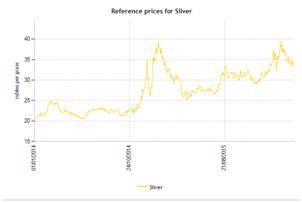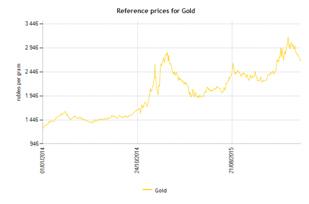Never before in modern history have central banks gone all out en masse with negative interest rates. First the US, then the Japanese, then the ECB, Swiss, English and then the Chinese joined the party; all trying to rear back inflation under control; throwing out the rule book and reopening the text books to get financial markets moving. As a result, yields on bonds worth over $6 trillion have headed negative. It is unsurprising that investor capital has run for precious metals.
At the European Central Bank’s 10th March meeting there were some radical monetary policy measures introduced to stimulate the economy: they dropped the base rate from 0.05% to zero and set the interest rate for deposits at minus 0.4%. The monthly asset purchasing program was increased from 60 to 80 billion euros, thereby increasing the money in circulation on the market. So what was gold’s reaction? A thirteen-month maximum against the dollar and a five-year maximum against the euro.
The price of gold correlates with the regulators’ interest rates, but not exactly as seems at first glance. To get a good idea, we need to take consider the US Fed’s rates. In theory, tightening monetary policy means increased yield on instruments on the stock market and leads to capital fleeing the gold market. Furthermore, a rise in interest rates theoretically leads to a strengthening of the dollar, meaning a fall in the price of gold as it is the currency in which the metal is sold.
The historical data tells us the opposite though. From 1970 to 1980, the Fed rate rose from 4% to 20%. In the same period, gold rocketed from $35 to $675 per ounce. Another example: before the period of financial crisis from 2003 to 2006, the federal fund interest rate increased from 1% to 5.5%. Gold quotes during this period reacted by growing from $355 to $650.
But a rise in interest rates from the Fed does not mean a rise in gold prices: it actually holds the price back. In both circumstances above, the rise in interest rates was preceded by inflation. Real negative interest rates in the States (federal fund rate minus CPI) have practically forever led to a new price maximum for gold.
In this there is nothing surprising since a widespread fall in interest rates in different countries has a positive effect on the price of precious metals. If we take into account the fact that the Fed, based on the Phillips curve, is trying to stimulate inflation, we receive a factor which is possible to support gold price growth over a sustained period of time.
The higher the price of gold, the stronger it will stand on its own two feet in light of the avalanche of demand which follows rises in gold prices. A fall of the stock market indices, negative interest rates for deposits, meagre growth of the world economy, in addition to rising political tensions have forced investors to search for a safe haven which has come in the form of gold.
So, as the purchases of precious metals gather pace with new players, the higher the price will rise for gold and silver. The situation will escalate when gold traded on the stock market in paper form begins to exceed the physical amount available.
So there is a precursor for a technical default. It wasn’t so long ago that COMEX, the largest precious metals market in the world, saw its reserves of accessible gold for immediate delivery fall by 73% due to a single and unexpected withdrawal. As such, at the end of January 2016, 99.81% of tradeable futures ended up unsecured by physical metal.
Now let's not forget about the central banks buying up record amounts of gold over the last eight years and joining the gold rush with the other market participants. Taking into account that the diverging demand and supply on the market (gold production in 2015 fell 4%, whilst demand rose by 4%), in addition to the modest size of global markets of physical gold and silver, we could well see a deficit come about.
Forecasts which are made in the review constitute the personal view of the author. Commentaries made do not constitute trade recommendations or guidance for working on financial markets. Alpari bears no responsibility whatsoever for any possible losses (or other forms of damage), whether direct or indirect, which may occur in case of using material published in the review
Recommended Content
Editors’ Picks
EUR/USD clings to daily gains above 1.0650

EUR/USD gained traction and turned positive on the day above 1.0650. The improvement seen in risk mood following the earlier flight to safety weighs on the US Dollar ahead of the weekend and helps the pair push higher.
GBP/USD recovers toward 1.2450 after UK Retail Sales data

GBP/USD reversed its direction and advanced to the 1.2450 area after touching a fresh multi-month low below 1.2400 in the Asian session. The positive shift seen in risk mood on easing fears over a deepening Iran-Israel conflict supports the pair.
Gold holds steady at around $2,380 following earlier spike

Gold stabilized near $2,380 after spiking above $2,400 with the immediate reaction to reports of Israel striking Iran. Meanwhile, the pullback seen in the US Treasury bond yields helps XAU/USD hold its ground.
Bitcoin Weekly Forecast: BTC post-halving rally could be partially priced in Premium

Bitcoin price shows no signs of directional bias while it holds above $60,000. The fourth BTC halving is partially priced in, according to Deutsche Bank’s research.
Week ahead – US GDP and BoJ decision on top of next week’s agenda

US GDP, core PCE and PMIs the next tests for the Dollar. Investors await BoJ for guidance about next rate hike. EU and UK PMIs, as well as Australian CPIs also on tap.

